Developing a Novel Adaptive Double Deep Q-Learning-Based Routing Strategy for IoT-Based Wireless Sensor Network with Federated Learning
Abstract
1. Introduction
- To perform data routing for IoT-aided WSN utilizing FL and the Q-learning-based approach. This data routing process allows the optimal path selection for transmitting the data packets from source to destination without any loss of packets and interruptions. The data routing process supports minimizing energy usage by choosing the optimal paths, thus extending the life span of the network. Moreover, this process improves the efficiency, reliability, and performance of the network by carefully selecting the best paths for data transmission in IoT-based WSNs.
- To design IRHO for fine tuning the parameters. The IRHO is developed by enhancing the exploitation stage of the traditional Hippopotamus Optimization Algorithm (HOA) with the support of an iteration-based random factor. This enhanced exploitation stage increases algorithm convergence and helps explore suitable solutions for the optimization problems. Moreover, by upgrading the conventional HOA, the designed IRHO mitigates the concern of premature convergence and also avoids high computations. The IRHO supports DDQL in choosing its parameters optimally during the data routing and decision-making operations thus helping to enhance the Packet Delivery Ratio (PDR), and minimize the delay and energy consumption.
- To present a novel FL-based ADDQL for performing the data routing and decision-making operations in IoT-based WSN. FL enables the distributed SNs in a WSN to collaborate and learn without transmitting original data to the intermediate server. The designed ADDQL learns the routing decisions and optimal policies on the basis of environmental feedback, thus optimizing the network performance. Here, the DDQL parameters are optimally selected by the IRHO. Thus, the integration of FL and ADDQL in data routing and decision-making operations in IoT-based WSN leads to enhanced efficiency, energy savings, adaptability, robustness, privacy, and scalability. These merits make the approach relatively suitable for dynamic, large-scale, and privacy-sensitive applications.
2. Existing Works
2.1. Related Works
2.2. Research Gaps and Challenges
- Conventional routing protocols in WSNs frequently result in high energy consumption because of regular data transmission and suboptimal routing paths, which ultimately shortens the network’s lifespan.
- Existing models fail to make effective use of available resources, such as bandwidth and energy, leading to diminished performance and high latency. As the number of IoT devices grows, these existing routing protocols find it challenging to sustain performance and efficiency, resulting in congestion and delays in data transmission.
- In existing models, the computational requirements of deep learning and the communication overhead associated with federated learning still contribute to increased energy consumption in resource-constrained sensor nodes.
- Existing routing models require more frequent updates and data exchanges between devices and the central server, which leads to higher communication costs and energy consumption.
- In existing models, data across different nodes are non-independent and identically distributed, which leads to challenges in training a robust global model. Addressing this issue proposed model requires optimal routing decisions based on energy consumption patterns, leading to more energy-efficient paths and increasing the lifetime of the network.
3. Implementation of Novel Routing Mechanism for IOT-Based WSN with Federated Learning
3.1. IoT-Enabled WSN Architecture
3.2. Contributions of FL in IoT-Based WSN
- Privacy preservation: FL enables the IoT systems to train the techniques collaboratively without data sharing, which is significant for the applications of privacy sensitivity.
- Data heterogeneity: FL allows the model’s training on distributed and diverse data sources, resulting in highly accurate and robust approaches.
- Reduced bandwidth consumption: By only sending the model updates instead of original data, FL conserves bandwidth and reduces the network traffic, which is relatively significant in the resource-constrained WSN domains.
- Flexibility and scalability: FC can scale to accommodate a huge amount of IoT systems and adapt to varying network conditions, making it effective for distinct applications of WSN.
- Continuous learning: IoT systems can learn and enhance their approaches on the basis of new data continuously, thus enabling the overall network to adapt to varying conditions and environments.
- Enhanced Model Performance: By employing data from a large range of systems, FL can result in highly generalizable and accurate approaches.
3.3. Detailed View of Proposed Routing Strategy
4. Development of a New Iteration-Based Random Factor of HO and Double Deep Q Learning for Routing Process
4.1. Developed IRHO
4.2. Double Deep Q Learning
5. Elucidation of Developed Adaptive Double Deep Q-Learning and FL-Based Routing and Decision Making with Multi-Objective Formulation
5.1. Introduced ADDQL with FL for Routing and Decision Making
5.2. Multi-Objective Formulation
6. Results and Discussion
6.1. Simulation Setup
6.2. Performance Measures
6.3. Convergence Analysis
6.4. Statistical Analysis
6.5. Reward Analysis
6.6. Penalty Analysis
6.7. Performance Analysis
6.8. Training Accuracy Analysis
7. Conclusions
Author Contributions
Funding
Institutional Review Board Statement
Informed Consent Statement
Data Availability Statement
Conflicts of Interest
References
- Ilyas, M.; Ullah, Z.; Khan, F.A.; Chaudary, M.H.; Malik, M.S.A.; Zaheer, Z.; Durrani, H.U.R. Trust-based energy-efficient routing protocol for Internet of things–based sensor networks. Int. J. Distrib. Sens. Netw. 2020, 16, 1550147720964358. [Google Scholar] [CrossRef]
- Baniata, M.; Reda, H.T.; Chilamkurti, N.; Abuadbba, A. Energy-efficient hybrid routing protocol for IoT communication systems in 5G and beyond. Sensors 2021, 21, 537. [Google Scholar] [CrossRef]
- Lakshmi, T.A.; Hariharan, B.; Prabha, R. An Energy Efficient Routing Protocol for Internet of Things Based Precision Agriculture. Inven. Comput. Technol. 2020, 4, 684–691. [Google Scholar]
- Hameed, A.R.; Islam, S.U.; Raza, M.; Khattak, H.A. Towards energy and performance-aware geographic routing for IoT-enabled sensor networks. Comput. Electr. Eng. 2020, 85, 106643. [Google Scholar] [CrossRef]
- Abdul-Qawy, A.S.H.; Srinivasulu, T. SEES: A scalable and energy-efficient scheme for green IoT-based heterogeneous wireless nodes. J. Ambient Intell. Humaniz. Comput. 2019, 10, 1571–1596. [Google Scholar] [CrossRef]
- Poornima, I.G.A.; Dontu, S.; Maheswaran, M.; Vallabhaneni, R. Energy-Effective Optimal Routing–Driven Hybrid Optimizations–Enabled IoT-Based Wearable Wireless Body Area Network. Int. J. Commun. Syst. 2025, 38, e70037. [Google Scholar] [CrossRef]
- Haseeb, K.; Islam, N.; Javed, Y.; Tariq, U. A lightweight secure and energy-efficient fog-based routing protocol for constraint sensors network. Energies 2020, 14, 89. [Google Scholar] [CrossRef]
- Al-Azez, Z.T.; Lawey, A.Q.; El-Gorashi, T.E.; Elmirghani, J.M. Energy efficient IoT virtualization framework with peer to peer networking and processing. IEEE Access 2019, 7, 50697–50709. [Google Scholar] [CrossRef]
- Butt, S.A.; Bakar, K.A.; Javaid, N.; Gharaei, N.; Ishmanov, F.; Afzal, M.K.; Mehmood, M.K.; Mujahid, M.A. Exploiting layered multi-path routing protocols to avoid void hole regions for reliable data delivery and efficient energy management for IoT-enabled underwater WSNs. Sensors 2019, 19, 510. [Google Scholar] [CrossRef]
- Thangaramya, K.; Kulothungan, K.; Logambigai, R.; Selvi, M.; Ganapathy, S.; Kannan, A. Energy aware cluster and neuro-fuzzy based routing algorithm for wireless sensor networks in IoT. Comput. Netw. 2019, 151, 211–223. [Google Scholar] [CrossRef]
- Saeedi, A.; Rafsanjani, M.K.; Yazdani, S. Energy efficient clustering in IoT-based wireless sensor networks using binary whale optimization algorithm and fuzzy inference system. J. Supercomput. 2025, 81, 1–49. [Google Scholar] [CrossRef]
- Khalaf, O.I.; Abdulsahib, G.M. Energy efficient routing and reliable data transmission protocol in WSN. Int. J. Adv. Soft Comput. Appl. 2020, 12, 45–53. [Google Scholar]
- Muhammed, T.; Mehmood, R.; Albeshri, A.; Alzahrani, A. HCDSR: A hierarchical clustered fault tolerant routing technique for IoT-based smart societies. In Smart Infrastructure and Applications: Foundations for Smarter Cities and Societies; Springer: Cham, Switzerland, 2020; pp. 609–628. [Google Scholar]
- Deepalakshmi, D.; Pushpa, B. Cognitive Fish Swarm Optimization for Multi-Objective Routing in IoT-based Wireless Sensor Networks utilized in Greenhouse Agriculture. Eng. Technol. Appl. Sci. Res. 2025, 15, 19472–19477. [Google Scholar] [CrossRef]
- Behera, T.M.; Mohapatra, S.K.; Samal, U.C.; Khan, M.S.; Daneshmand, M.; Gandomi, A.H. I-SEP: An improved routing protocol for heterogeneous WSN for IoT-based environmental monitoring. IEEE Internet Things J. 2019, 7, 710–717. [Google Scholar] [CrossRef]
- Zeb, A.; Ali, Q.; Saleem, M.Q.; Awan, K.M.; Alowayr, A.S.; Uddin, J.; Iqbal, S.; Bashir, F. A Proposed IoT-Enabled Smart Waste Bin Management System and Efficient Route Selection. J. Comput. Netw. Commun. 2019, 2019, 7043674. [Google Scholar] [CrossRef]
- Humayun, M.; Jhanjhi, N.; Alamri, M. IoT-based Secure and Energy Efficient scheme for E-health applications. Indian J. Sci. Technol. 2020, 13, 2833–2848. [Google Scholar] [CrossRef]
- Rahmani, A.M.; Haider, A.; Ali, S.; Mohammadi, M.; Mehranzadeh, A.; Khoshvaght, P.; Hosseinzadeh, M. A routing approach based on combination of gray wolf clustering and fuzzy clustering and using multi-criteria decision making approaches for WSN-IoT. Comput. Electr. Eng. 2025, 122, 109946. [Google Scholar] [CrossRef]
- Zhang, Y.; Liu, M.; Tan, A. Delay-Sensitive Multi-Sensor Routing Scheduling Method for Underground IoT in Mines. Sensors 2025, 25, 369. [Google Scholar] [CrossRef]
- Akbari, Y.; Tabatabaei, S. A new method to find a high reliable route in IoT by using reinforcement learning and fuzzy logic. Wirel. Pers. Commun. 2020, 112, 967–983. [Google Scholar] [CrossRef]
- Farahani, M.; Rahbar, A.G. Double leveled unequal clustering with considering energy efficiency and load balancing in dense iot networks. Wirel. Pers. Commun. 2019, 106, 1183–1207. [Google Scholar] [CrossRef]
- Amiri, M.H.; Hashjin, N.M.; Montazeri, M.; Mirjalili, S.; Khodadadi, N. Hippopotamus optimization algorithm: A novel nature-inspired optimization algorithm. Sci. Rep. 2024, 14, 5032. [Google Scholar] [CrossRef] [PubMed]
- Suresh, S.S.; Prabhu, V.; Parthasarathy, V.; Senthilkumar, G.; Gundu, V. Intelligent data routing strategy based on federated deep reinforcement learning for IOT-enabled wireless sensor networks. Meas. Sens. 2024, 31, 101012. [Google Scholar] [CrossRef]
- Udayaprasad, P.; Shreyas, J.; Srinidhi, N.; Kumar, S.D.; Dayananda, P.; Askar, S.S.; Abouhawwash, M. Energy efficient optimized routing technique with distributed SDN-AI to large scale I-IoT networks. IEEE Access 2024, 12, 2742–2759. [Google Scholar] [CrossRef]
- Arafat, M.Y.; Pan, S.; Bak, E. Distributed energy-efficient clustering and routing for wearable IoT enabled wireless body area networks. IEEE Access 2023, 11, 5047–5061. [Google Scholar] [CrossRef]
- Samadi, R.; Nazari, A.; Seitz, J. Intelligent energy-aware routing protocol in mobile IoT networks based on SDN. IEEE Trans. Green Commun. Netw. 2023, 7, 2093–2103. [Google Scholar] [CrossRef]
- Prabhu, V.; Parthasarathy, V. An intelligent data routing strategy based on deep reinforcement learning for IoT enabled WSNs. e-Prime-Adv. Electr. Eng. Electron. Energy 2023, 6, 100298. [Google Scholar]
- Han, H.; Tang, J.; Jing, Z. Wireless sensor network routing optimization based on improved ant colony algorithm in the Internet of Things. Heliyon 2024, 10, e23577. [Google Scholar] [CrossRef]
- Kumar, N.; Singh, K.; Lloret, J. WAOA: A hybrid whale-ant optimization algorithm for energy-efficient routing in wireless sensor networks. Comput. Netw. 2024, 254, 110845. [Google Scholar] [CrossRef]
- Bhimshetty, S.; Ikechukwu, A.V. Energy-efficient deep Q-network: Reinforcement learning for efficient routing protocol in wireless internet of things. Indones. J. Electr. Eng. Comput. Sci. 2024, 33, 971–980. [Google Scholar] [CrossRef]
- Kumar, M.; Shahwar, T.; Gokulnath, C. Improved Sensor Localization with Intelligent Trust Model in Heterogeneous Wireless Sensor Network in Internet of Things (IoT) Environment. Sustain. Comput. Inform. Syst. 2025, 46, 101122. [Google Scholar] [CrossRef]
- Saqhib, M.N.; Lakshmikanth, S. Augmenting relay node selection for improved energy efficiency in non-hierarchical IoT-oriented wireless sensor networks using Q-learning and fuzzy logic. Comput. Electr. Eng. 2025, 123, 110068. [Google Scholar] [CrossRef]
- Archana, M.; Swathi, V.; Vathsala, A.V.; Reddy, K.D.; Rambabu, B.; Reddy, J.R. Energy-Efficient and Sustainable Cluster-Based Routing in IoT Based WSNs Using Metahueristic Optimization. In Proceedings of the 2025 6th International Conference on Mobile Computing and Sustainable Informatics (ICMCSI), Goathgaun, Nepal, 7–8 January 2025; pp. 79–83. [Google Scholar]
- Narwaria, A.; Kumari, V.; Mazumdar, A.P. RL-EAR: Reinforcement learning-based energy-aware routing for software-defined wireless sensor network. J. Supercomput. 2025, 81, 485. [Google Scholar] [CrossRef]
- Gebremariam, G.G.; Panda, J.; Indu, S. Blockchain-Based Secure Localization against Malicious Nodes in IoT-Based Wireless Sensor Networks Using Federated Learning. Wirel. Commun. Mob. Comput. 2023, 2023, 8068038. [Google Scholar] [CrossRef]
- Sattibabu, G.; Ganesan, N.; Kumaran, R.S. IoT-enabled wireless sensor networks optimization based on federated reinforcement learning for enhanced performance. Peer-Peer Netw. Appl. 2025, 18, 75. [Google Scholar] [CrossRef]
- Bin Issa, R.; Das, M.; Rahman, M.S.; Barua, M.; Rhaman, M.K.; Ripon, K.S.N.; Alam, M.G.R. Double deep Q-learning and faster R-Cnn-based autonomous vehicle navigation and obstacle avoidance in dynamic environment. Sensors 2021, 21, 1468. [Google Scholar] [CrossRef]
- Agushaka, J.O.; Ezugwu, A.E.; Abualigah, L. Gazelle optimization algorithm: A novel nature-inspired metaheuristic optimizer. Neural Comput. Appl. 2023, 35, 4099–4131. [Google Scholar] [CrossRef]
- Abualigah, L.; Diabat, A.; Mirjalili, S.; Elaziz, M.A.; Gandomi, A.H. The arithmetic optimization algorithm. Comput. Methods Appl. Mech. Eng. 2021, 376, 113609. [Google Scholar] [CrossRef]
- Azli, H.; Titri, S.; Larbes, C.; Kaced, K.; Femmam, K. Novel yellow saddle goatfish algorithm for improving performance and efficiency of PV system under partial shading conditions. Sol. Energy 2022, 247, 295–307. [Google Scholar] [CrossRef]
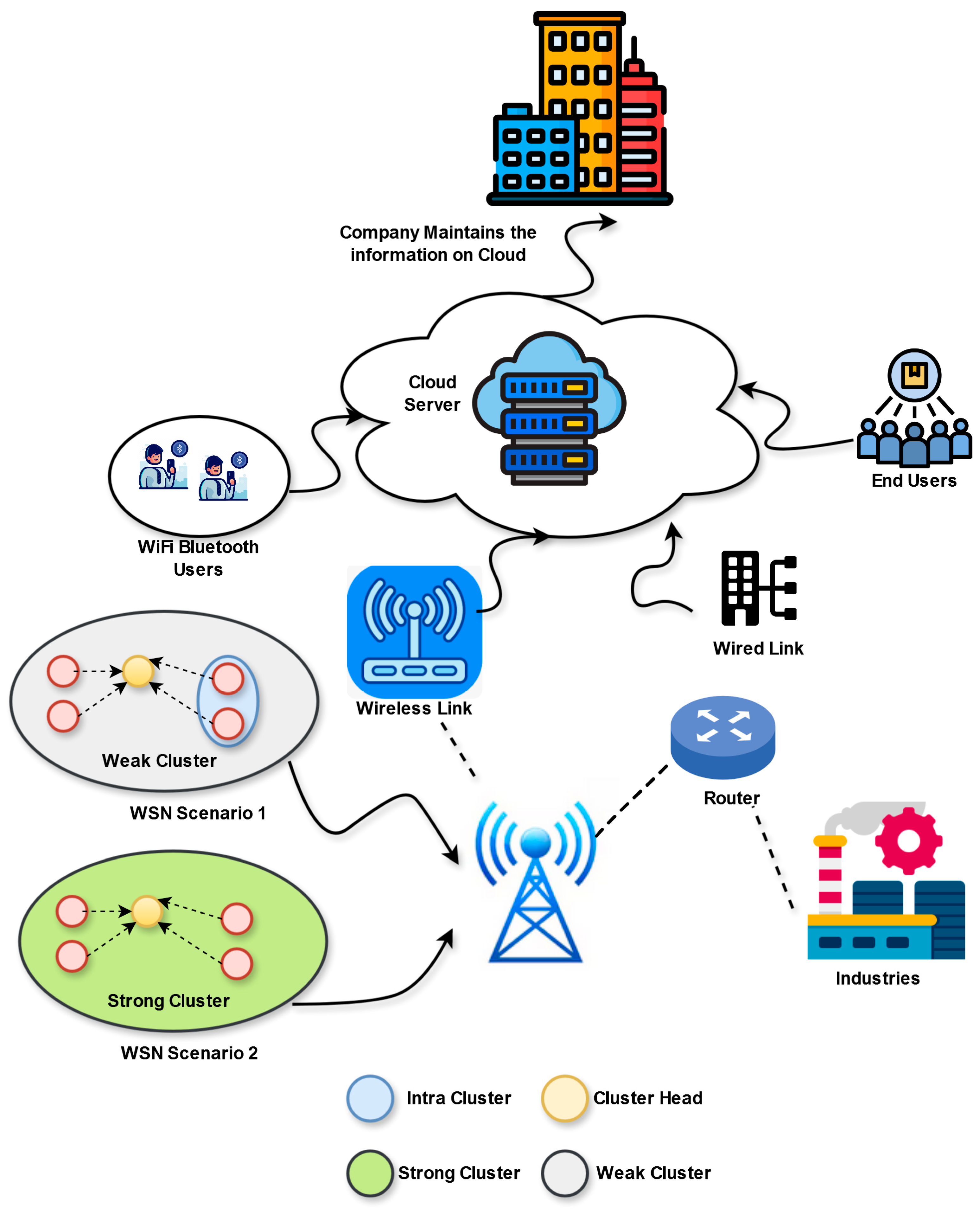
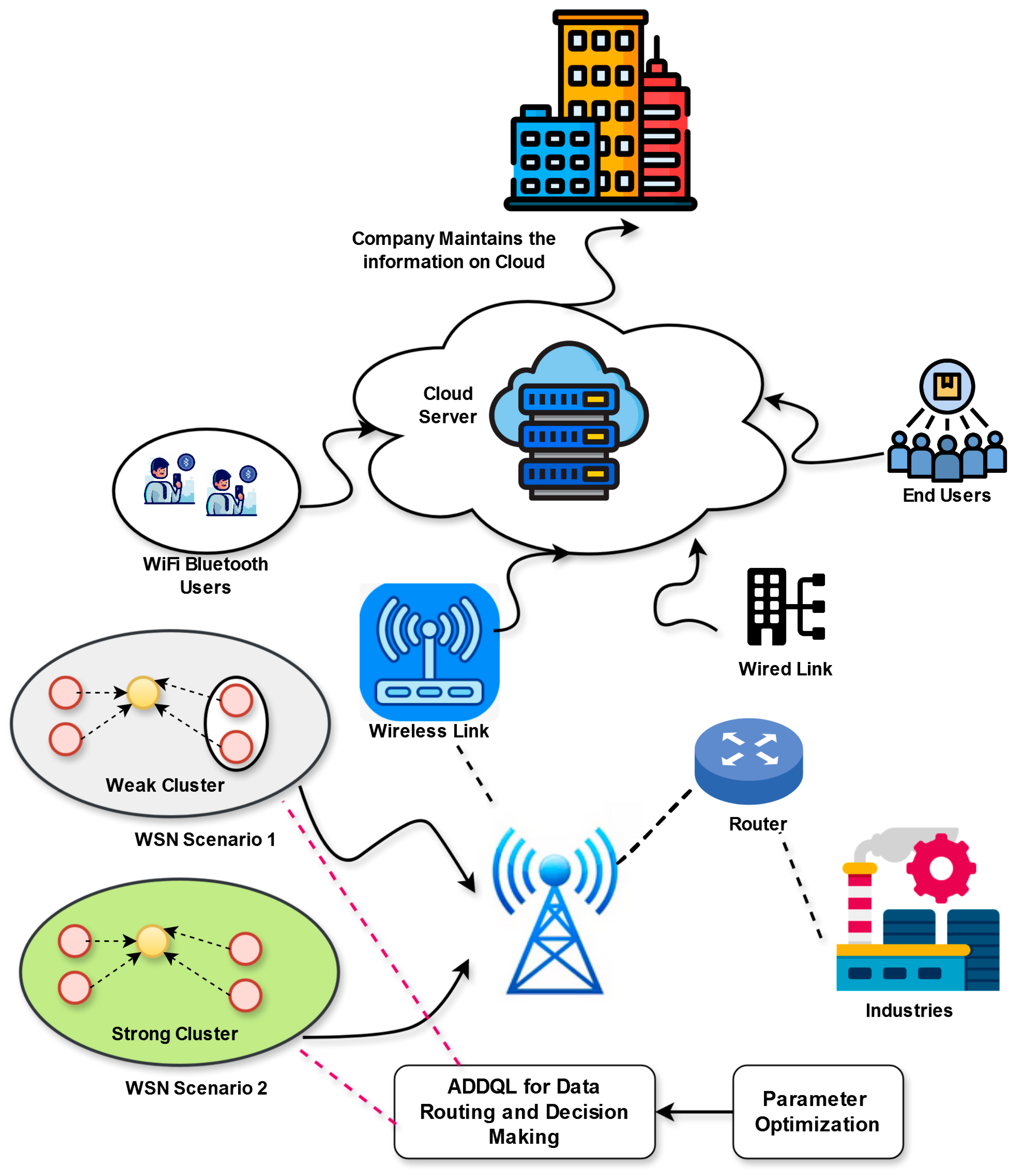

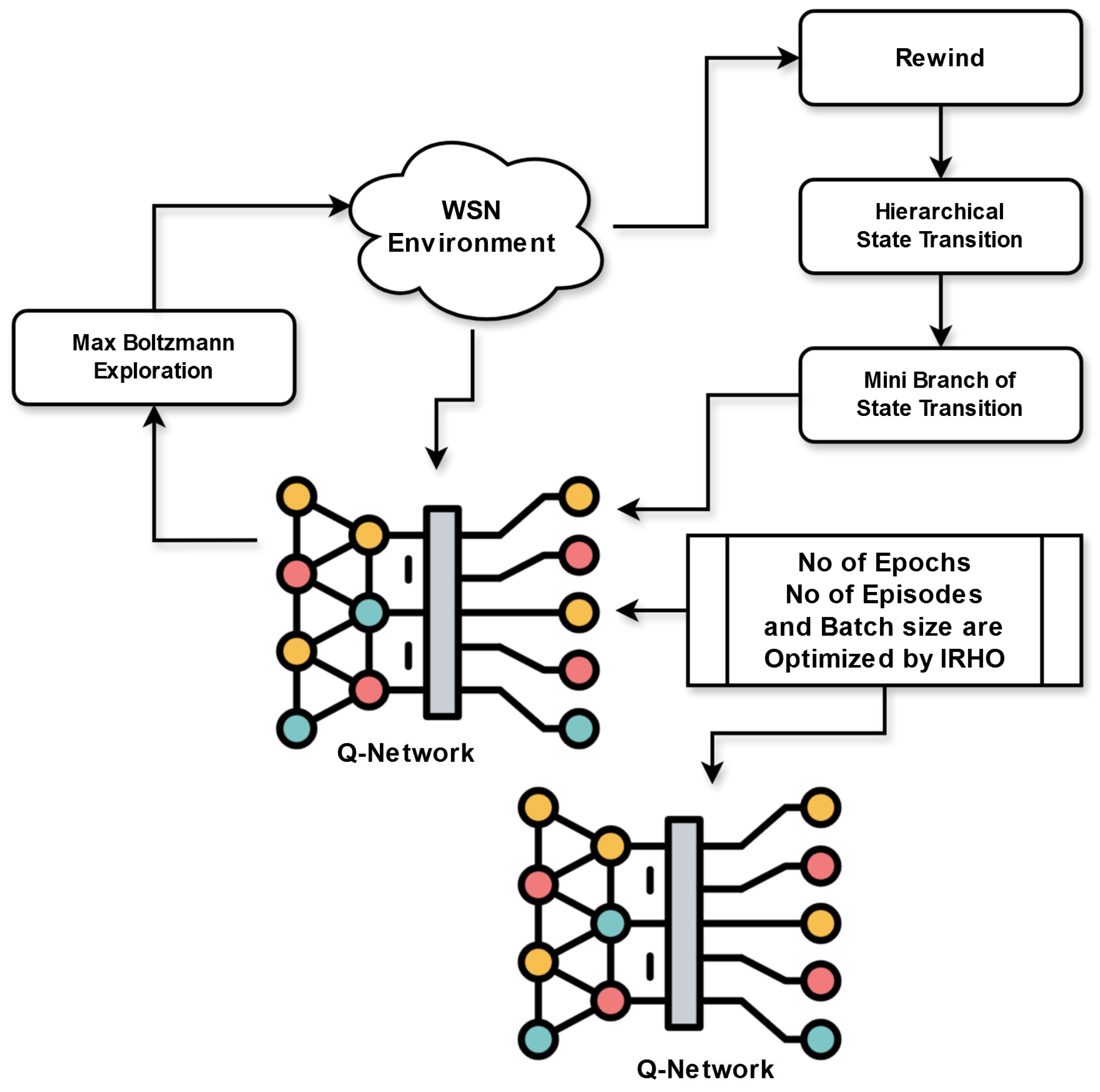
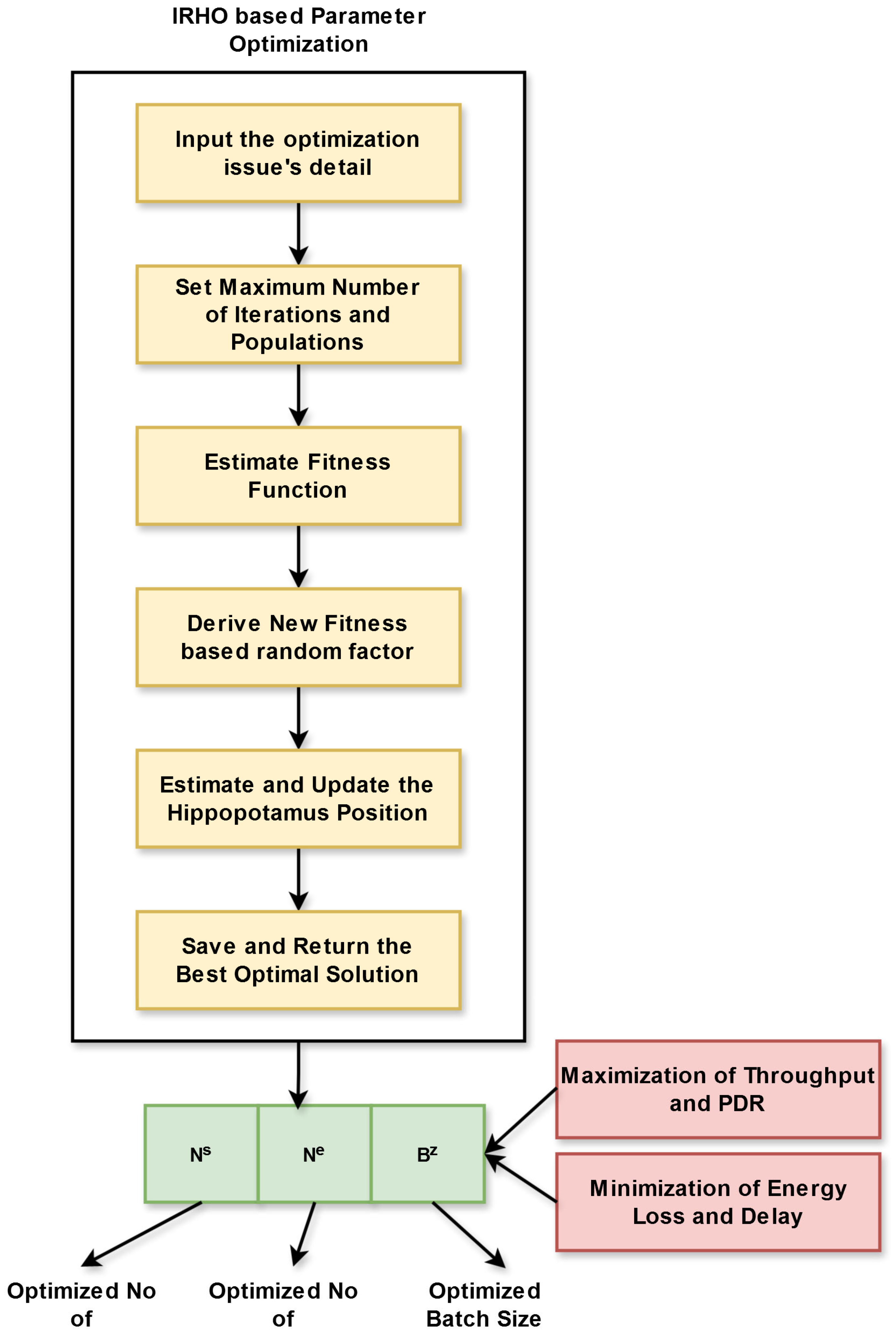
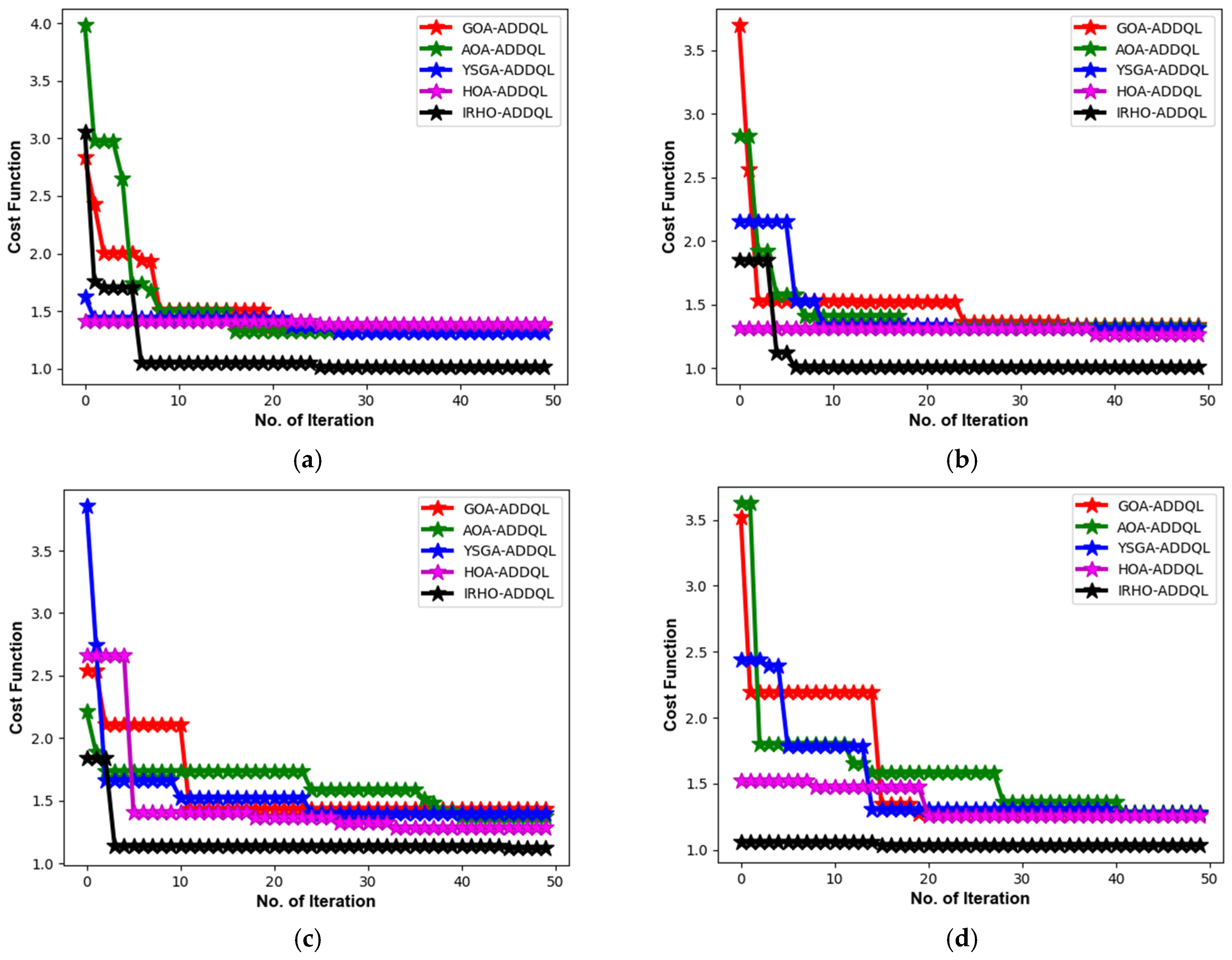
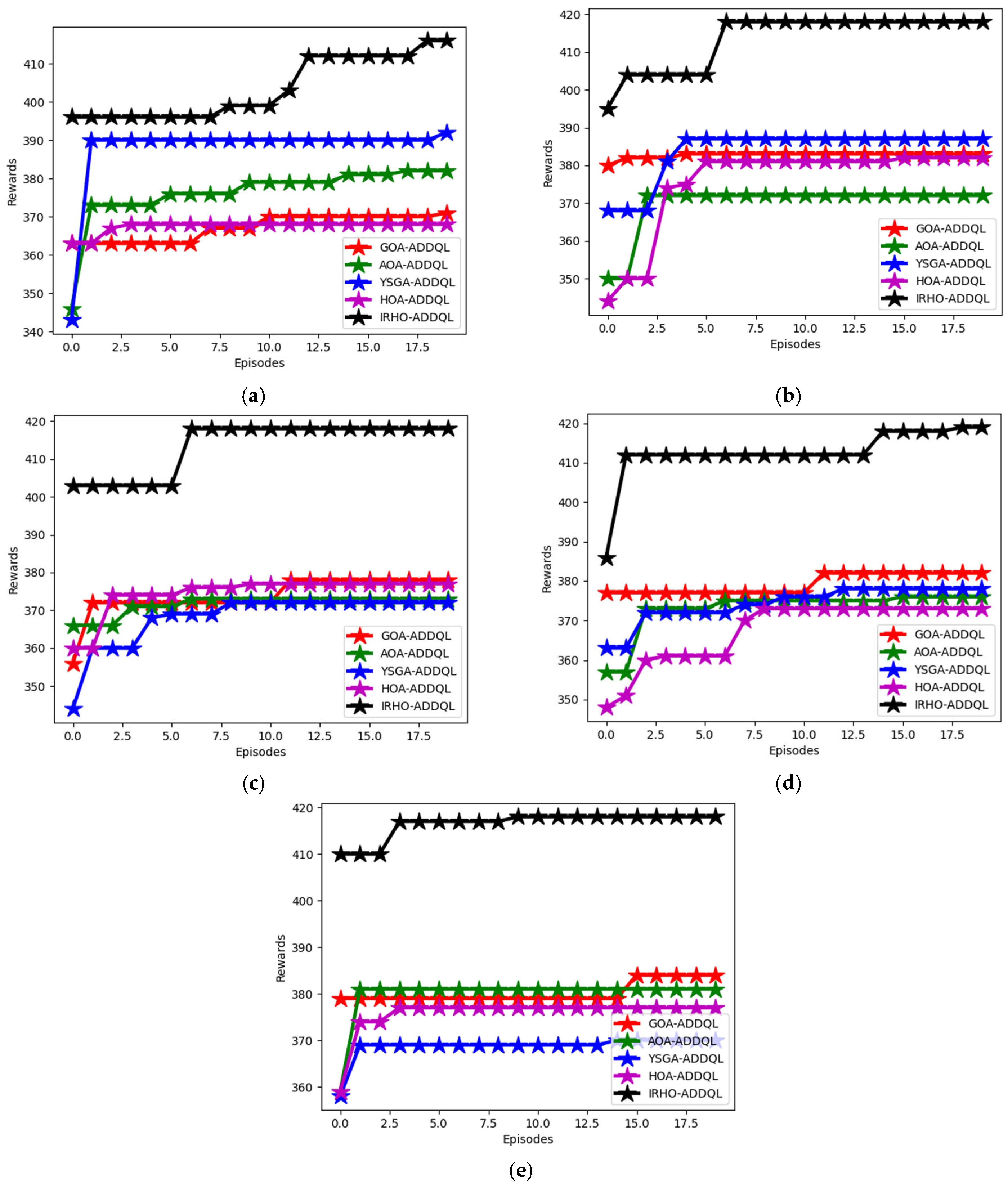
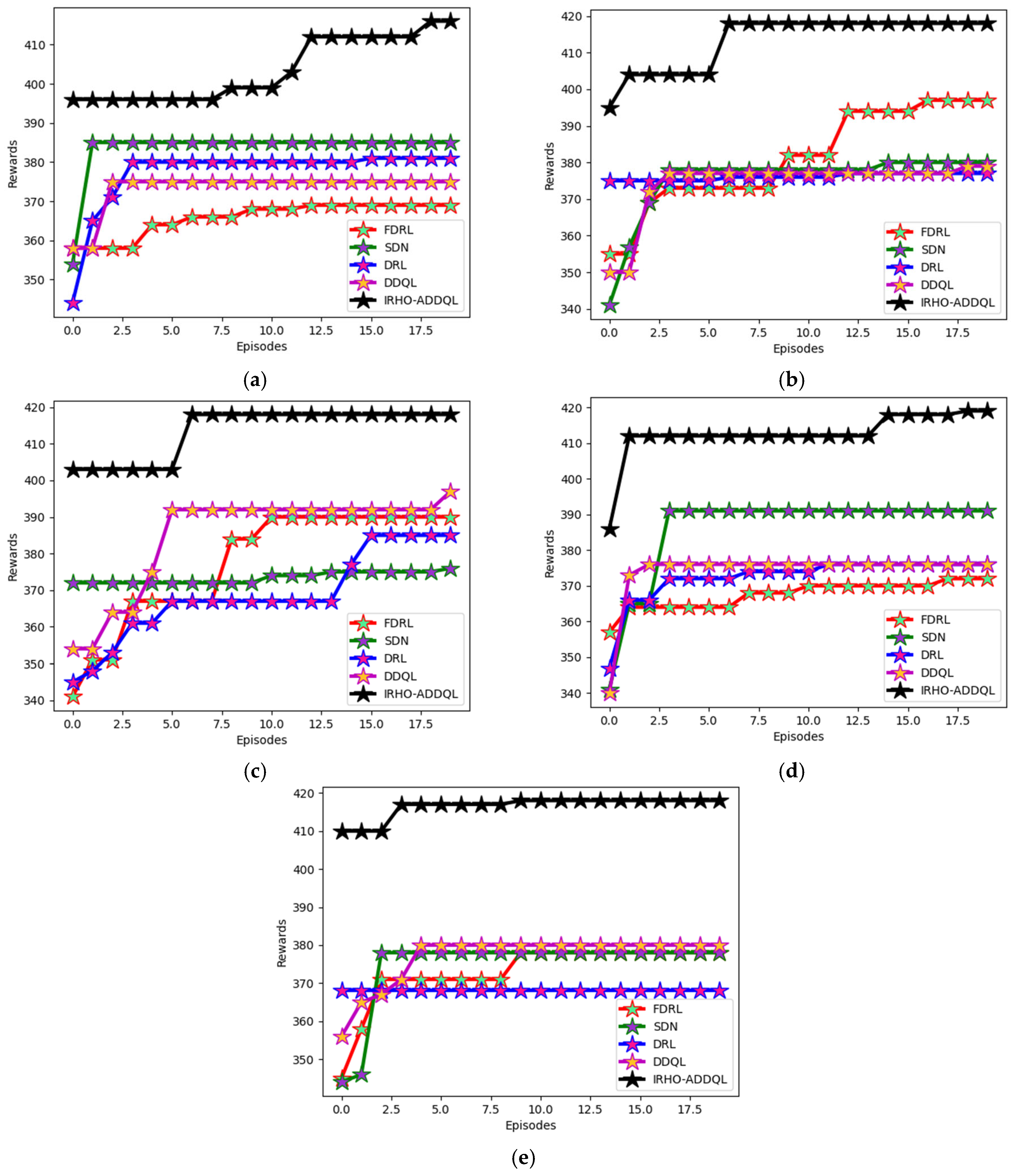
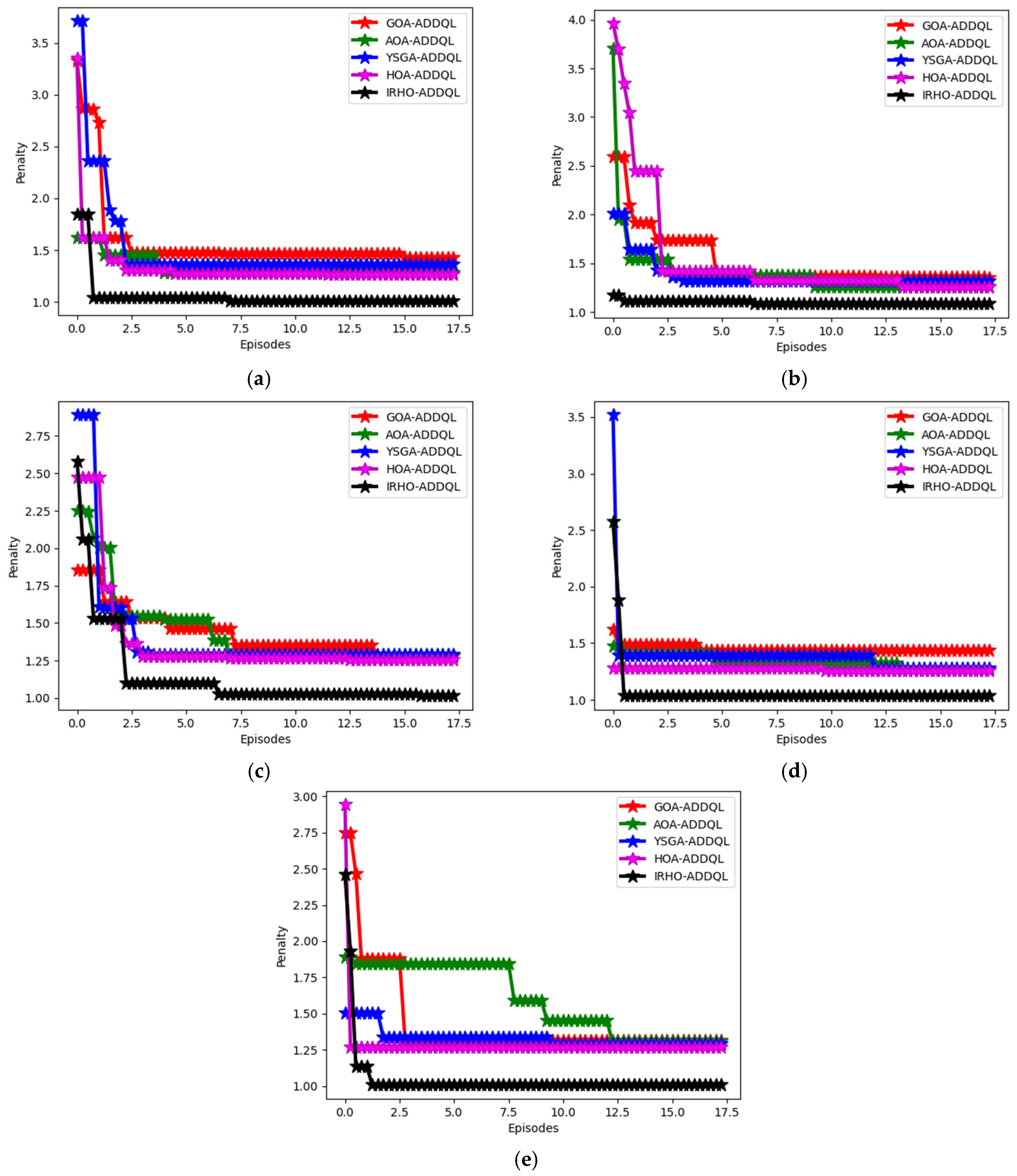
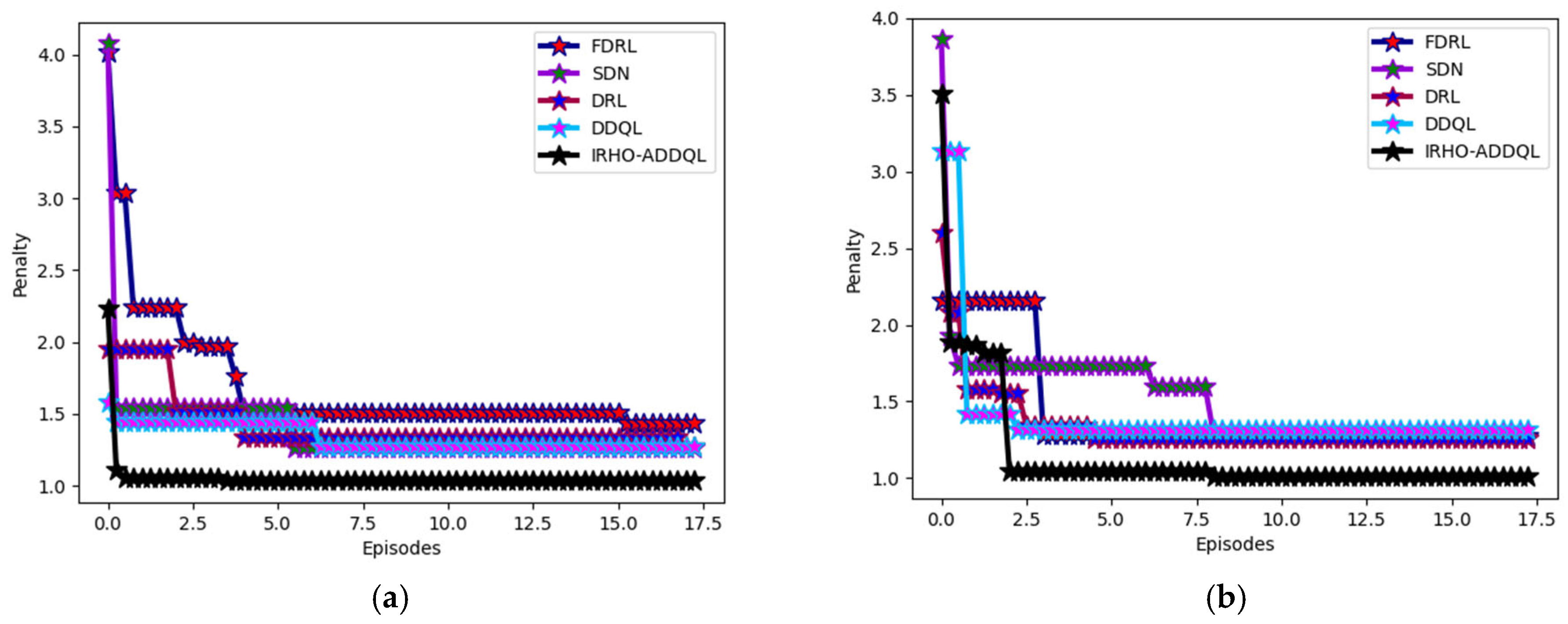
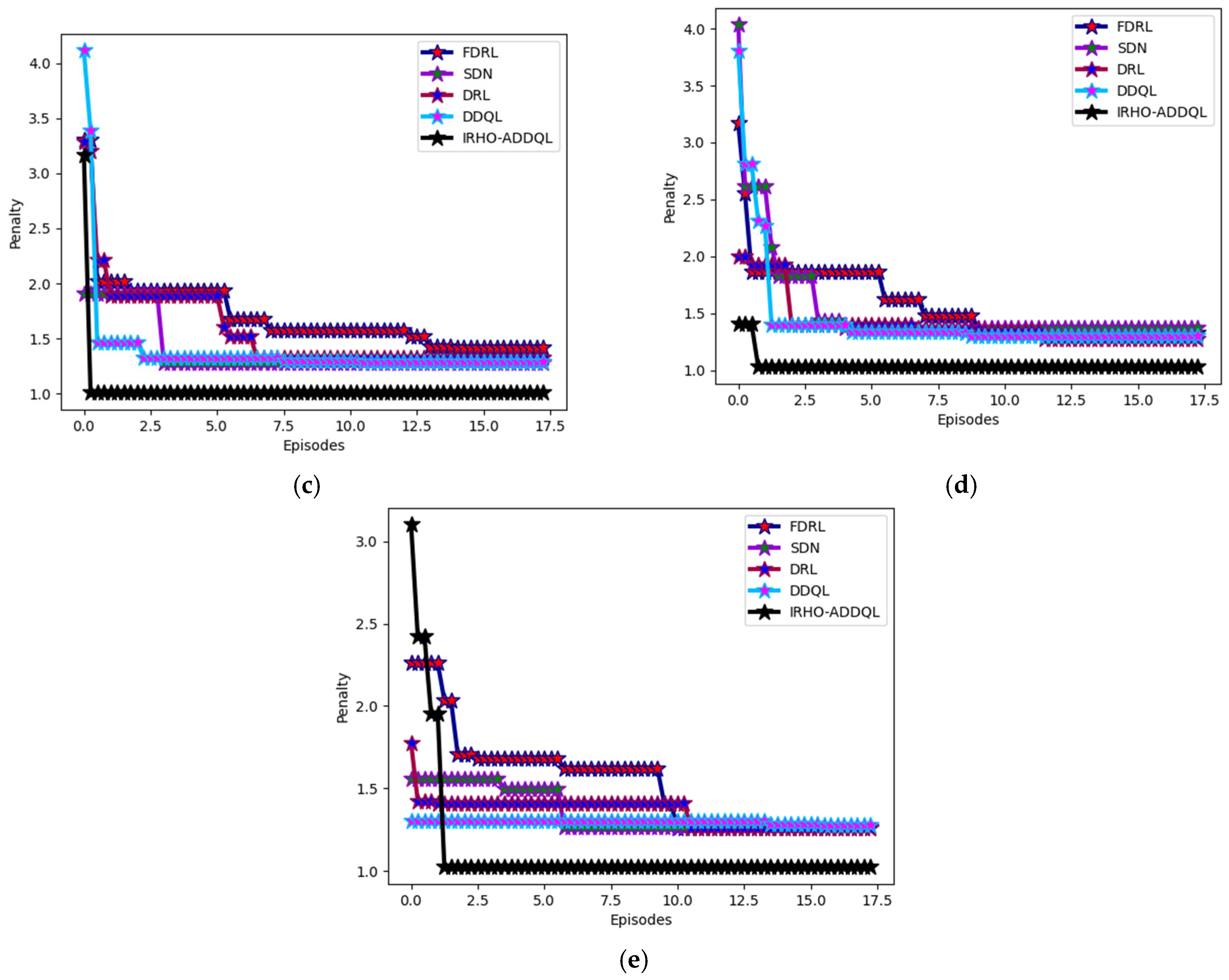


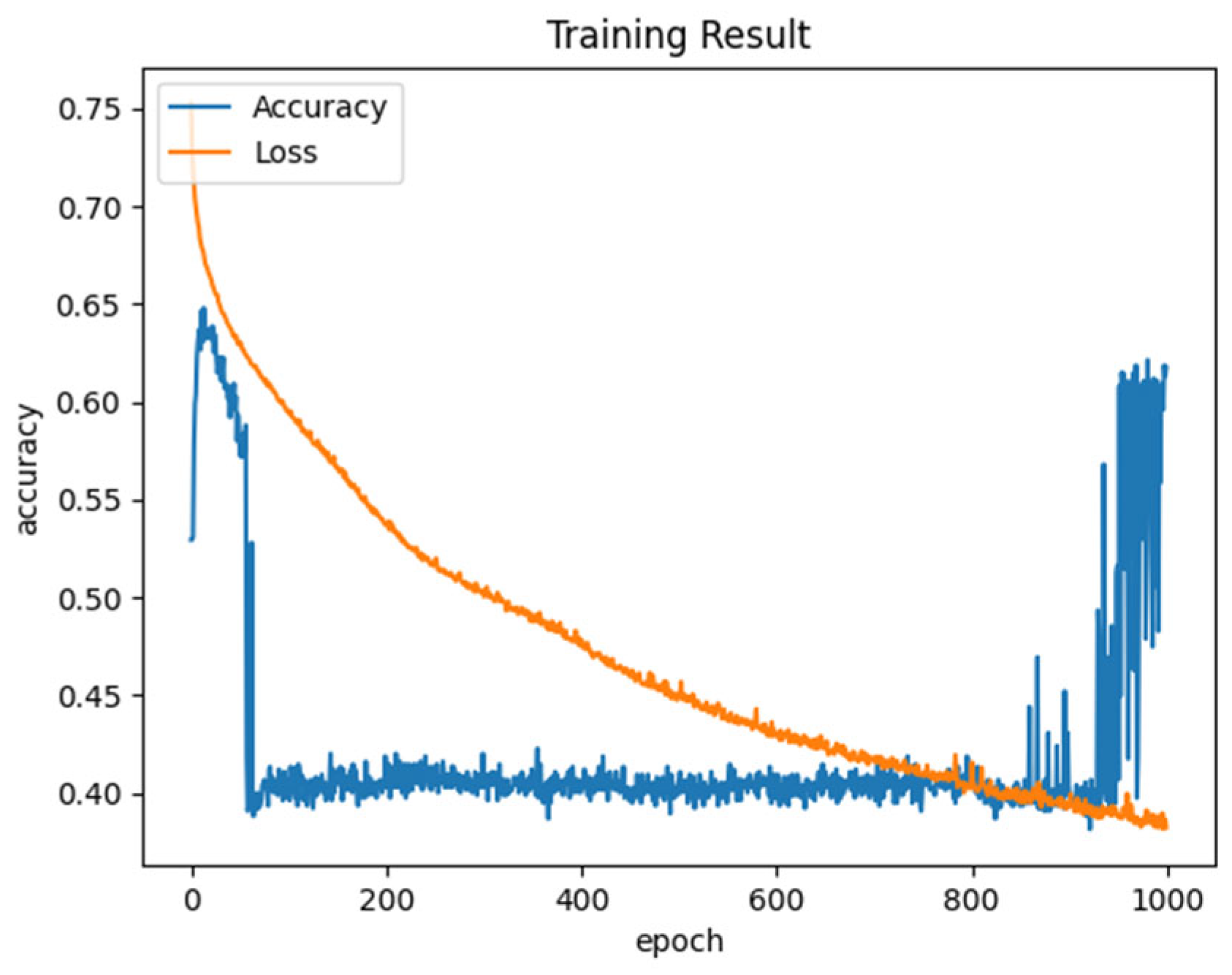
| Author | Methodology | Features | Challenges |
|---|---|---|---|
| Suresh et al. [23] | FDRL |
|
|
| Udayaprasad et al. [24] | SDN |
|
|
| Arafat et al. [25] | DECR |
|
|
| Samadi et al. [26] | IERMIoT |
|
|
| Prabhu et al. [27] | DRL |
|
|
| Han et al. [28] | IACA |
|
|
| Kumar et al. [29] | WAOA |
|
|
| Bhimshetty et al. [30] | FCM |
|
|
| Terms | GOA-ADDQL [30] | AOA-ADDQL [31] | YSGA-ADDQL [32] | HOA-ADDQL [26] | IRHO-ADDQL |
|---|---|---|---|---|---|
| Number of nodes:50 | |||||
| Best | 1.367221717 | 1.327008471 | 1.315670531 | 1.386346225 | 1.011547396 |
| Worst | 2.831332739 | 3.980690416 | 1.626239545 | 1.413434657 | 3.05679448 |
| Mean | 1.525548043 | 1.556621933 | 1.377247497 | 1.399890441 | 1.138022068 |
| Median | 1.367369675 | 1.327008471 | 1.365544027 | 1.399890441 | 1.031302392 |
| Standard deviation | 0.301230716 | 0.547754415 | 0.066549634 | 0.013544216 | 0.343626462 |
| Number of nodes:100 | |||||
| Best | 1.332472208 | 1.326900929 | 1.309793984 | 1.263856025 | 1.005139131 |
| Worst | 3.693216301 | 2.827998823 | 2.15336773 | 1.308682711 | 1.848050982 |
| Mean | 1.493420211 | 1.443468693 | 1.431838731 | 1.298085009 | 1.077143893 |
| Median | 1.36076299 | 1.326900929 | 1.309793984 | 1.308682711 | 1.005139131 |
| Standard deviation | 0.362508366 | 0.309654231 | 0.271264286 | 0.018859319 | 0.228424785 |
| Number of nodes:150 | |||||
| Best | 1.431118549 | 1.37264242 | 1.400124174 | 1.28150209 | 1.119324721 |
| Worst | 2.53964408 | 2.211246869 | 3.855050805 | 2.658863984 | 1.840534949 |
| Mean | 1.596759987 | 1.6173011 | 1.552274902 | 1.472464296 | 1.175925251 |
| Median | 1.431118549 | 1.583170264 | 1.400124174 | 1.366782707 | 1.135191288 |
| Standard deviation | 0.321650977 | 0.171043547 | 0.38560915 | 0.39866155 | 0.167977677 |
| Number of nodes:250 | |||||
| Best | 1.270923584 | 1.279334609 | 1.274006028 | 1.258950045 | 1.032041414 |
| Worst | 3.520591482 | 3.625904359 | 2.436391899 | 1.517943624 | 1.057422979 |
| Mean | 1.580626418 | 1.597013528 | 1.498258271 | 1.351401436 | 1.039655884 |
| Median | 1.270923584 | 1.579958457 | 1.30830824 | 1.258950045 | 1.032041414 |
| Standard deviation | 0.49503774 | 0.454303056 | 0.358325157 | 0.11414003 | 0.011631294 |
Disclaimer/Publisher’s Note: The statements, opinions and data contained in all publications are solely those of the individual author(s) and contributor(s) and not of MDPI and/or the editor(s). MDPI and/or the editor(s) disclaim responsibility for any injury to people or property resulting from any ideas, methods, instructions or products referred to in the content. |
© 2025 by the authors. Licensee MDPI, Basel, Switzerland. This article is an open access article distributed under the terms and conditions of the Creative Commons Attribution (CC BY) license (https://creativecommons.org/licenses/by/4.0/).
Share and Cite
Manogaran, N.; Raphael, M.T.M.; Raja, R.; Jayakumar, A.K.; Nandagopal, M.; Balusamy, B.; Ghinea, G. Developing a Novel Adaptive Double Deep Q-Learning-Based Routing Strategy for IoT-Based Wireless Sensor Network with Federated Learning. Sensors 2025, 25, 3084. https://doi.org/10.3390/s25103084
Manogaran N, Raphael MTM, Raja R, Jayakumar AK, Nandagopal M, Balusamy B, Ghinea G. Developing a Novel Adaptive Double Deep Q-Learning-Based Routing Strategy for IoT-Based Wireless Sensor Network with Federated Learning. Sensors. 2025; 25(10):3084. https://doi.org/10.3390/s25103084
Chicago/Turabian StyleManogaran, Nalini, Mercy Theresa Michael Raphael, Rajalakshmi Raja, Aarav Kannan Jayakumar, Malarvizhi Nandagopal, Balamurugan Balusamy, and George Ghinea. 2025. "Developing a Novel Adaptive Double Deep Q-Learning-Based Routing Strategy for IoT-Based Wireless Sensor Network with Federated Learning" Sensors 25, no. 10: 3084. https://doi.org/10.3390/s25103084
APA StyleManogaran, N., Raphael, M. T. M., Raja, R., Jayakumar, A. K., Nandagopal, M., Balusamy, B., & Ghinea, G. (2025). Developing a Novel Adaptive Double Deep Q-Learning-Based Routing Strategy for IoT-Based Wireless Sensor Network with Federated Learning. Sensors, 25(10), 3084. https://doi.org/10.3390/s25103084








